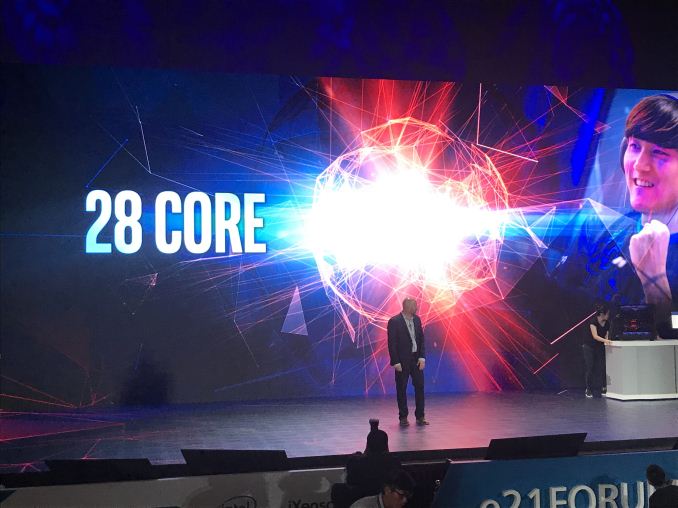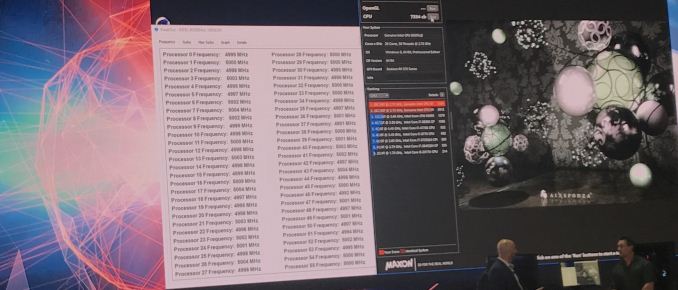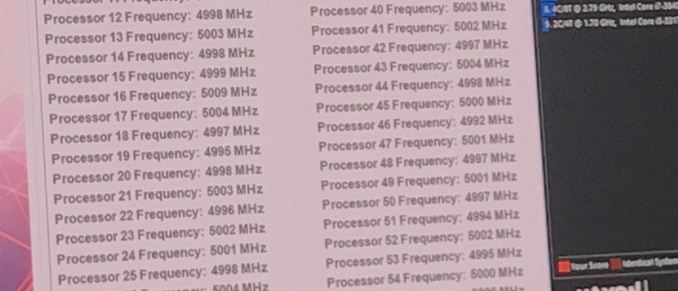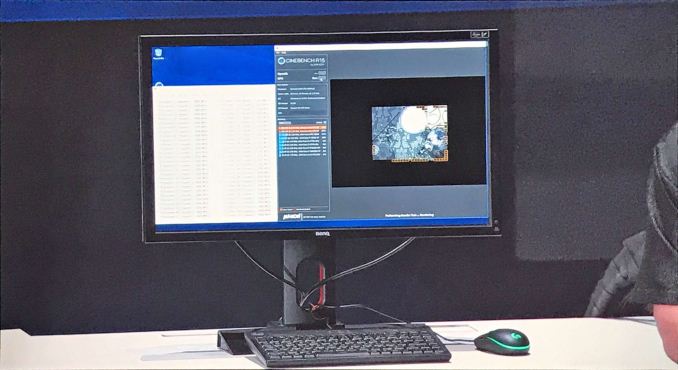Intel’s 28-Core 5 GHz CPU: Coming in Q4
by Ian Cutress on June 5, 2018 3:09 AM EST- Posted in
- CPUs
- Intel
- Trade Shows
- Computex 2018
- 28-core

Update 06/08: Intel has since backtracked on its initial statements, clarifying that while a 28-core part is coming in Q4 of this year, its stock frequency will not be 5GHz. Rather this was a (very poorly communicated) overclocking demo of the upcoming part. For more details, please see this article.
Alongside the launch of Intel’s first 5 GHz processor, the 6-core Core i7-8086K, Intel today also showcased a 28-core single socket machine also running at 5 GHz. The system on display scored 7334 in Cinebench R15, and Gregory Bryant (SVP and GM of Intel Client Computing Group) explicitly stated that it would be coming in Q4 this year.
No other details were provided, however for it to exist in a current platform, this new processor would likely be in LGA2066 (X299) or LGA3647 (the server socket). Intel technically already makes 28-core monolithic designs in the Intel Xeon Scalable Platform with the Xeon Platinum 8180, which is a $10k processor, which runs a lot slower than 5.0 GHz.
Personally, I feel this new processor is not a higher binned Platinum 8180. Going up from 2.8 GHz base / 3.5 GHz turbo to 5.0 GHz all-core frequency is a big step, assuming the 5.0 GHz value was not an overclock. I would fully expect that this is the point where Intel starts introducing EMIB to CPUs. (ed: FWIW, I disagree with Ian; my money is on a heavily binned 28-core XCC processor made on 14++. We've seen that Intel can do 5GHz on that process with the 8086K)
Last week I discussed the potential death of Intel’s low-end core design for high-end desktop, because it was being eclipsed by the mainstream parts. The only way Intel would be able to reuse the server versions of those low-core count designs would be to enable its embedded multi-die interconnect bridge (EMIB) technology to put two or more of the smaller dies on the same package. This would allow Intel do amortize costs in the same way AMD does by making use of higher yielding parts (as die size goes down, yield goes up).
Intel’s EMIB has a potentially high bi-directional bandwidth, so it would be interesting to see if Intel would bind two dies together and if there is any additional latency or bandwidth decrease with two dies together. With 28 cores, that would subdivide by two to 14-each, but not to four. So this processor is likely to be two 14-core dies using EMIB… which would actually be Intel’s HCC (high-core-count) processor design.
To add something extra to the mix, Intel might not be using EMIB at all. It could just as easily be the QPI interface on package, much how the company is using the Xeon + FPGA products announced recently.
So our primary questions to Intel would be:
- Monolithic or multi-die
- QPI or EMIB
- Socket
- Die size
- TDP / Power consumption at 5 GHz
TDP is a big part of the equation here. 28 cores at 5.0 GHz doesn’t come for free. The next questions are around price and launch date.
Additional:
There's the discussion about cutting into Intel's 1P market with such a product. But also, consider that at CES that Supermicro rated their X299 motherboards as supporting 300W processors, so it could easily correlate this processor to LGA2066 and a 300W TDP. That would be... fun... I guess?
| Want to keep up to date with all of our Computex 2018 Coverage? | ||||||
 Laptops |
 Hardware |
 Chips |
||||
| Follow AnandTech's breaking news here! | ||||||













87 Comments
View All Comments
.vodka - Tuesday, June 5, 2018 - link
Okay, where's the LN2 pot? It can't be running in that case next to the monitor. Even if they'd fit a beefy custom WC loop in there, I don't think it'd be able to handle the instantaneous load of 28 cores @ 5GHz, not on a single die. Unless they've bamboozled everyone and that thing is built on a particularly spectacular version of their 10nm process that makes 14++ look like a bad joke....Single magical 28 core die, EMIB + two 14 core dies or not, what kind of ridiculously overengineered VRM did that motherboard have to handle that load?
So many questions.
haukionkannel - Tuesday, June 5, 2018 - link
It could be using compressor. They can go quite low temperatures and Also cost a fortuneteller by themselves.https://www.alphacool.com/detail/index/sArticle/21...
http://www.ldcooling.com/shop/ld-pc-v2/191-ld-pc-v...
0ldman79 - Tuesday, June 5, 2018 - link
They could always load up slowly, the reverse of the current turbo system where it peaks quickly then drops off, have the 28 core ramp to the halfway point slowly then clock up as possible.Honestly, they're probably going to have to start doing that as the chips get bigger. We have to do that in the real world with various electric motors, combustion engines, etc...
They can engineer the power delivery to handle the burst load but the sudden increase in heat will be an issue...
That's a lot of amps with a small surface area to cool it with.
0ldman79 - Tuesday, June 5, 2018 - link
I meant to say hit the halfway clock speed quickly then ramp up slowly.Can't edit these, can we?
HStewart - Tuesday, June 5, 2018 - link
"Single magical 28 core die, EMIB + two 14 core dies"As far as I seen, EMIB is not used for Two 14 cores. Intel has a Xeon with 28 cores already, if it had two cores it would likely be 2 28 cores instead. But it is likely 28 Core plus a graphics core - possibly even something totally new
As far as it being 28 cores at 5Ghz - it looks like from images that it is. EMIB likely been enhanced to handle power reduction to handle. Time will tell what other area will be used - but likely some kind of graphics and graphic's memory like XPS 15 2in1 I am typing this on.
KingOftoasty - Wednesday, June 6, 2018 - link
Paul's Hardware had a video in which he showed that they were using a chiller below the desk. That would seem to indicate that there's no way this thing can achieve a 5 Ghz all-core clock on air or liquid cooling, given that it's probably a cannibalized xeon platinum/skylake x.Lolimaster - Thursday, June 7, 2018 - link
They were using a chiller for -10°C, intel made an embarrassment at their own show.Bulat Ziganshin - Tuesday, June 5, 2018 - link
It's not a big problem to RUN all cores at 5 GHz. Hey, it was possible back in 2011! The only problem is to take off all the heat, which may be around 500 Watt. It may be possible with scalping and high-end water cooling. But i guess that this CPU will be for hard-core enthusiasts and costs in 5-10K range.Tamz_msc - Tuesday, June 5, 2018 - link
In the first screenshot Cinebench reads 2.7 GHz. So some variant of the 8180?What will be the power consumption be like for 28 cores at 5 GHz. A 7900X when pushed to the limit under P95 approaches 500W, I'd imagine that this thing will easily approach 1.2-1.5 KW. That's more than what extreme over lockers push on GPUs under LN2.
HStewart - Tuesday, June 5, 2018 - link
"In the first screenshot Cinebench reads 2.7 GHz. So some variant of the 8180?"Look closer at images - this Cinebench benchmark at the 2.7Ghz is not this CPU - but like other benchmarks - those comparison systems and not actual testing system